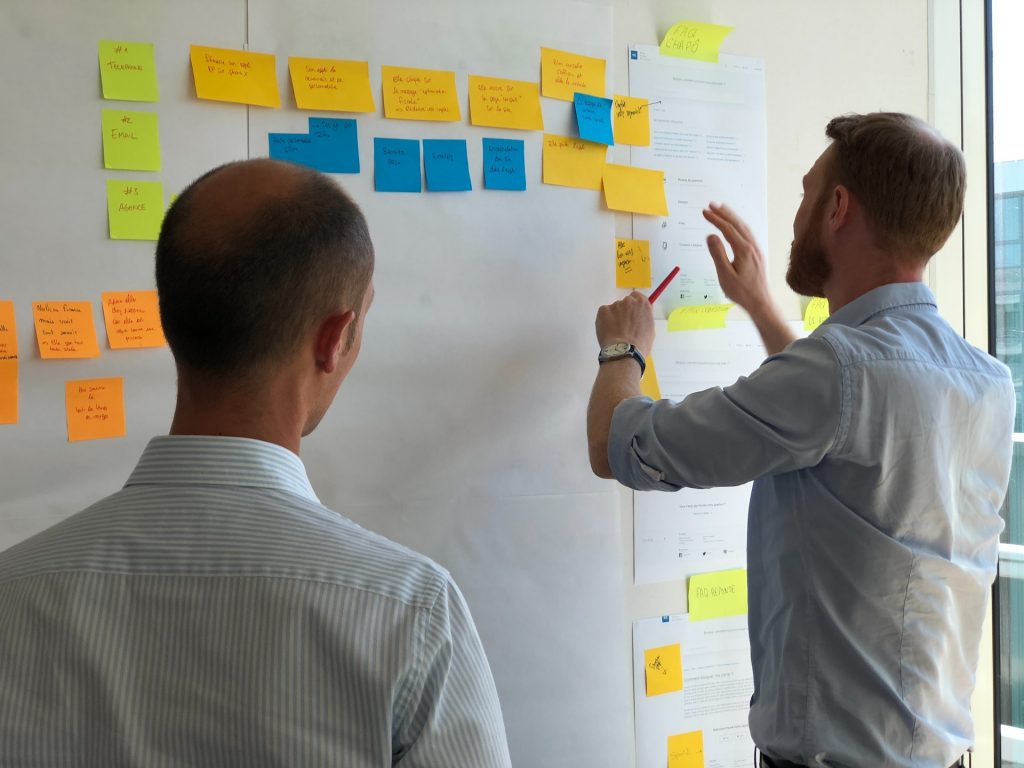
What Are User Stories & What Role They Play In Agile Development
Jerry Wallis
16 min read

User stories are an essential tool in Agile development methodologies. They help bridge the gap between customers and development teams by providing a clear understanding of the users’ needs and expectations.
Agile development approaches, such as Scrum and Kanban, have gained popularity due to their flexibility and ability to deliver high-quality software in iterative cycles.
If you’re running a business that involves web or software development, chances are you’ve heard of user stories. But what exactly are they, and how do they fit into the agile methodology? User stories play an important role in product development, but it can be difficult to understand how best to make use of them for your project.
User stories are the building blocks of these methodologies, enabling effective collaboration and prioritisation within the development team.
In this article, we will explore what user stories are, their significance in Agile development, and how they contribute to the success of a project. We’ll also unpack the best way to integrate them into your agile process if you plan on building successful products!
What Are User Stories? 📖
User stories are concise, simple descriptions of a feature or functionality from the perspective of an end-user or stakeholder. They capture the “who,” “what,” and “why” of a requirement, focusing on the user’s needs rather than technical details. Each user story represents a small, testable piece of functionality that delivers value to the user.
The user story, in essence, encapsulates the requirements and functionalities of the product that the user wants. These users could be internal stakeholders or even colleagues who will use the software.
User stories help clarify the value a feature can add to a product and assist in understanding why users want specific functionality. In agile software development, user stories shift the focus of product managers and the development team from writing about software features to discussing them. Teams can write these on index cards or sticky notes to engage in more meaningful discussions during the development phase. By focusing the conversation on the user, they can create a better product and user experience.
At the same time, content development teams can use this methodology to create more meaningful content that resonates with the target audience. User stories help content creators understand how the topic will impact readers before the content creation begins. This process leads to a more focused content strategy, creating user-centred content and collaboration with other team members. Ultimately, content user stories operate similarly to product development, requiring a reader-first approach to content creation.
Lastly, user stories serve as fundamental components within broader agile frameworks such as epics and initiatives. Epics encompass substantial work items that are further decomposed into a collection of stories, while initiatives consist of multiple epics. These overarching structures guarantee that the development team’s daily efforts, focusing on these stories, align with the organisational objectives embedded within epics and initiatives.
Why Are User Stories Important In Agile Development? 🤸🏼♂️
When it comes to agile development, newcomers often view user stories as an extra hurdle. Why not simply divide the extensive project (the epic) into a sequence of actions/tasks and proceed? However, stories provide the team with vital context and link tasks to the value they deliver.
🤝 Encourage Communication & Collaboration
They facilitate effective communication and collaboration among team members. By using a common language and understanding the user’s perspective, developers, testers, and product owners can work together efficiently. Collaboration thrives through the use of stories. By establishing a clear objective, the team can unite their efforts and collectively determine the most effective way to serve the user and achieve that objective.
🙋♂️ Customer-Centric Approach
Secondly, user stories encourage customer-centricity. They shift the focus from a technical standpoint to the user’s needs, ensuring that the development process aligns with the desired outcomes. This leads to improved customer satisfaction and a higher chance of meeting business objectives.
The power of stories lies in their ability to captivate and engage users. Unlike a mere to-do list that merely guides a team towards ticking off tasks, a compilation of stories directs the team’s attention towards finding solutions that truly address user needs.
🗂️ Compliments The Agile Philosophy
Thirdly, user stories promote flexibility and adaptability. Since they are small and manageable units, they can be easily reprioritised or modified as per changing requirements. This allows development teams to respond quickly to feedback and deliver incremental value throughout the project.
⏩ Stories Accelerate Development
A great thing about stories is that they generate momentum. As each story is conquered, the development team experiences both a small challenge and a small triumph, fueling their motivation and propelling them forward.
Components Of A User Story 🧩
A typical user story consists of the following components.
- Role: Describes the user or stakeholder involved.
- Goal: States the objective or desired outcome.
- Benefit: Highlights the value or benefit the user will gain.
- The Definition Of Done: The narrative reaches a state of completion when the user can successfully accomplish the designated task. However, it is crucial to establish a precise definition for this achievement.
- Breakdown Of Subtasks Or Tasks: Determine the specific actions that need to be accomplished and assign responsibility to the individuals involved.
- Consider User Personas: Who are the intended beneficiaries? If there are multiple end users, it is advisable to create separate narratives for each.
- Sequential Progression: Craft a narrative for every step within a broader process, ensuring a clear and organised flow.
- Embrace User Feedback: Engage in conversations with your users and accurately capture their concerns or requirements in their own words. Rather than speculating on narratives, tap into the valuable insights provided by your customers.
- Time Considerations: Time can be a sensitive matter. Numerous development teams evade discussions surrounding time, instead relying on estimation frameworks. Given that stories should be accomplishable within a single sprint, it is advisable to divide extensive tasks that might take weeks or months into smaller stories or designate them as their own epics.

By structuring user stories this way, teams can better understand the user’s motivations and tailor their solutions accordingly. So, once they have been finalised and clearly defined, it’s important to distribute them to the entire team to ensure everyone’s on the same wavelength.
A Typical User Story Format 💁♀️
User stories follow a simple format that captures the essence of the requirement. They are often written in the following template:
As a <role>, I want <goal> so I can <benefit>.
In terms of a formula, you can summarise this template format as persona + need + purpose.
This format provides clarity and enables easy comprehension of the user’s intent.
🧾 User Story Examples
For example, by following this template format, a user story could look something along the lines of the following.
Example #1: As a customer, I want to add items to my shopping cart and proceed to checkout effortlessly so that I can complete my purchase smoothly.
Example #2: As a social media user, I want to receive notifications for new messages so that I can stay updated with the latest interactions.
Example #3: As a project manager, I want to generate detailed reports on team productivity so that I can evaluate performance and make informed decisions.
Example #4: As a website visitor, I want to easily navigate through different sections so that I can find the information I need quickly.
Example #5: As a user, I want to be able to create an account so that I can access personalised features and store my preferences.
Example #6: As a customer, I want to be able to add items to my shopping cart and proceed to checkout easily so that I can quickly complete my purchase.
Example #7: As a manager, I want to be able to generate reports on sales and revenue by a specific time period so that I can analyse the performance of my business.
Example #8: As a student, I want to be able to search for and enrol in online courses based on my interests so that I can enhance my knowledge and skills.
Example #9: As a social media user, I want to be able to upload and share photos with my friends so that I can document and showcase memorable moments in my life.
Creating Effective User Stories ✍
To create effective user stories, it’s essential to involve key stakeholders, including end-users, throughout the process. Here are some tips for creating an impactful user story.
🔗 Collaborate
Engage with users and stakeholders to gather insights and perspectives. Regularly review and iterate on the user stories with the collaborative team. This iterative process allows for continuous feedback and refinement, ensuring that the stories remain relevant and aligned with the evolving project requirements. By fostering a culture of collaboration and involving diverse perspectives, you can create stories that are comprehensive, well-rounded and ultimately lead to the development of a successful product.
⭐ Keep It Simple
Focus on the user’s needs without getting into technical details. To keep these stories simple, focus on capturing the core essence of the user’s need or requirement. Avoid unnecessary details or technical jargon that may confuse or overwhelm stakeholders. Use clear and straightforward language that is easily understood by everyone involved.
Clarity is also crucial in user stories. Clearly define the user’s goal or objective, the action they need to perform, and the desired outcome. Avoid ambiguity or vague descriptions that could lead to misunderstandings or misinterpretations. Clearly articulate the who, what, and why of each user story.
Conciseness is another key to conveying information efficiently. Keep them concise by using short, concise sentences or phrases. Be mindful of unnecessary repetition or excessive elaboration. Focus on conveying the essential information in a succinct manner.
🔥 Prioritise
Rank user stories based on their importance and value to the user. By considering important prioritisation factors such as – user impact, business value, required effort and feasibility, you can rank them based on their importance and value to the user effectively. Remember that this prioritisation may evolve over time as new information becomes available or priorities shift, so it’s important to reassess and adjust the ranking as needed regularly.
📝 Define Acceptance Criteria
Clearly outline the conditions that must be met for a user story to be considered complete. This is achieved through the definition of done (DOD). This is essential in user stories as it establishes clear criteria for completion, ensures shared understanding, maintains quality, promotes transparency, aligns with user expectations, facilitates continuous improvement, and determines release readiness. By adhering to a well-defined DoD, teams can deliver high-quality and valuable features to users consistently.
🌟 Refine & Iterate
Continuously refining user stories based on feedback and evolving requirements is crucial because it allows for adaptation and improvement over time. By incorporating feedback from stakeholders and users, as well as staying updated on evolving requirements, a user story can be refined to better align with the desired outcomes and deliver maximum value. This iterative process ensures that these stories remain relevant, address changing needs, and ultimately lead to the development of successful products or features.
User Stories Vs Use Cases ⚔️
User stories are often compared to use cases, another popular requirement-gathering technique. So, how are they different? Or do both mean the same thing? While both serve the purpose of capturing requirements, there are notable differences between the two.
Use cases tend to be more detailed and formal, focusing on interactions between actors and the system. On the other hand, user stories prioritise simplicity, user-centricity, and flexibility.
In contrast to user stories, use cases provide a more detailed and structured representation of how users interact with a system or software application. Use cases typically consist of a narrative or flow that describes a sequence of interactions between the user and the system, detailing the steps, inputs, and expected outputs. Use cases are often associated with more traditional or formal software development methodologies.
While user stories focus on the “what” and capture user value, use cases delve deeper into the “how” and provide a more comprehensive understanding of system behaviour and user interactions. Use cases are useful for complex systems, documenting detailed system requirements and facilitating communication between stakeholders, including developers, designers, and testers.
Where Do User Stories Fit In Agile Development? 🤷♀️
🏃 Sprint Iteration
User stories fit seamlessly into the agile development process. They are typically managed in a product backlog, where they are continuously refined, estimated, and prioritised. During sprint planning, these stories are selected from the backlog and broken down into smaller tasks for development and testing. This iterative approach allows for regular feedback, adaptation, and the delivery of value incrementally.
💼 Managing Requirements
In the Agile development process, user stories hold a pivotal role, particularly within frameworks like Scrum. They serve as the primary medium for capturing and managing requirements. Collaboration between the product owner, stakeholders, and development team is essential during the initial stages of an Agile project to write and refine these stories.
📅 For Agile Estimation & Task Planning
When it comes to Agile planning and estimation sessions, user stories undergo scrutiny and prioritisation based on their significance and value. The development team breaks down these stories into smaller, actionable tasks or sub-tasks that can be completed within a single iteration or sprint. This breakdown aids in estimation, task allocation, and progress tracking.
🗃️ A Key Constituent Of The Product Backlog
Typically, user stories find their place in a dynamic product backlog—a comprehensive list encompassing all desired features or stories for the product. The product owner, in tandem with stakeholders, continuously refines and reorganises the backlog, taking into account feedback, evolving market needs, and changing requirements.
For each sprint, the development team handpicks a set of stories from the product backlog to focus on. This selection forms the sprint backlog, serving as the foundation for development activities during the sprint. Close collaboration within the development team ensues to implement, test, and deliver these stories, aiming to complete them within the sprint’s designated time frame.
💬 Facilitate Team Communication & Collaboration
Throughout the Agile development process, user stories serve as a communication tool, fostering conversations among team members, stakeholders, and the product owner. They foster a shared understanding of deliverables and facilitate frequent feedback and adaptation based on input from users and stakeholders.
Benefits, Challenges, Best Practices 🤷♀️
✨ Benefits Of User Stories In Agile
Using user stories in Agile development offers several benefits, the primary of which are below.
- Improved Collaboration: User stories foster collaboration and shared understanding among team members.
- Customer Satisfaction: They keep the focus on the user, increasing the chances of delivering the desired outcomes and enhancing customer satisfaction.
- Flexibility: They are flexible and adaptable, allowing teams to respond to changing requirements effectively.
- Transparency: They provide transparency into project progress and enable stakeholders to track the development team’s work.
- Incremental Value Delivery: They facilitate the delivery of incremental value throughout the development process, ensuring that the most valuable features are prioritised.
🚧 Challenges In Creating User Stories
Although user stories offer numerous advantages, there are also challenges associated with creating them. By being aware of these challenges, teams can proactively address them and ensure the effective proper implementation of user stories. Some of the biggest and most common challenges include:
- Ambiguity: User stories may sometimes lack clarity, leading to misunderstandings or misinterpretations.
- Scope Creep: Without proper control, user stories can expand beyond their intended scope, impacting project timelines and goals.
- Dependency Management: Managing dependencies between user stories can be complex, especially in larger projects.
- Technical Details: Striking the right balance between user-centricity and technical requirements can be challenging.
🎯 Best Practices For Writing User Stories
To create effective user stories, consider the following best practices.
- User Involvement: Involve all relevant end-users and stakeholders in the creation and refinement of user stories.
- Small & Manageable: Keep user stories small and manageable to facilitate incremental development and value delivery.
- Testability: Ensure user stories can be easily tested, allowing for validation and verification.
- Independent: Write user stories that are independent of each other to prevent unnecessary dependencies.
- Negotiable: User stories should be open to negotiation and refinement based on evolving requirements and priorities.

User Stories in Different Agile Frameworks 📊
User stories are widely used in various Agile frameworks, including Scrum, Kanban, and Extreme Programming (XP). While the specific implementation may vary, the underlying principles and benefits remain consistent across these frameworks. That said, let’s explore how user stories are utilised in some popular Agile frameworks.
🤼♂️ Scrum
In Scrum, user stories are a fundamental component of the product backlog. The product owner, in collaboration with stakeholders, writes and prioritises user stories based on their value and importance. During sprint planning, the development team selects a set of user stories from the product backlog and breaks them down into actionable tasks. These tasks are then completed within the sprint’s time frame. User stories act as a communication tool, enabling collaboration and fostering a shared understanding among team members.
🧮 Kanban
In Kanban, user stories are represented as work items on the Kanban board. The product backlog contains a list of user stories, which are pulled into the “To-Do” column when the development team has the capacity to work on them. As the team progresses, user stories move across different columns, representing different stages of completion. Kanban emphasises continuous flow and limits the amount of work in progress (WIP), ensuring that user stories are completed before new ones are pulled into the workflow.
💥 Extreme Programming (XP)
In Extreme Programming, user stories are used to capture customer requirements and drive development iterations. User stories are written collaboratively with the customer, who provides the desired functionality from the end-user perspective. XP teams prioritise user stories based on customer value, and each iteration focuses on implementing a set of user stories. Frequent customer feedback and involvement ensure that user stories accurately represent the customer’s needs and enable the development team to deliver value incrementally.
💾 Lean Software Development
In Lean Software Development, user stories are used to identify customer value and eliminate waste. User stories are written to capture specific customer requirements and are refined through collaboration with stakeholders. The focus is on delivering value and minimising waste by continuously assessing the user stories’ impact on customer satisfaction. The development team uses user stories as a tool to improve the flow of value delivery and streamline the development process.
Conclusion: User Stories In Agile Development 🎇
User stories play a vital role in Agile development by enabling effective communication, promoting customer-centricity, and facilitating incremental value delivery.
By capturing the user’s needs and desired outcomes, user stories bridge the gap between customers and development teams. However, creating effective user stories requires collaboration, simplicity, and continuous refinement.
When done correctly, user stories can help bridge the gap between customers and developers and facilitate value delivery along the way.
If your team is looking for a product development partner who understands Agile and knows how to create effective user stories, we’d love to chat. We specialise in agile development methods, so if your team wants to discuss building a custom software or app with us, book a discovery call with our team today and let’s get started as soon as possible!
Topics
Published On
June 02, 2023

